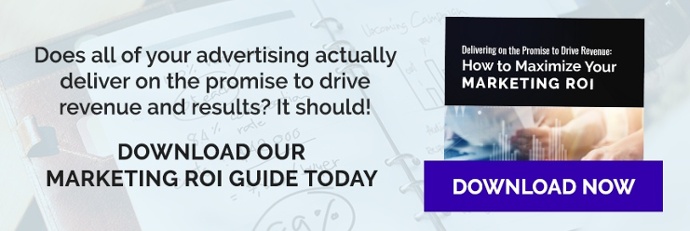 Believe it or not, 18% of small businesses admit that they don’t track any metrics or key performance indicators (KPI) related to their marketing, however, tracking marketing metrics is critical to the success of every marketing campaign, not to mention an overall marketing strategy. That’s because marketing metrics are the only way to know for sure that you’re seeing the results that you need, along with the ROI you want, from each of your marketing efforts. Without them, you have to guess whether you’re reaching your audience effectively, spending your marketing budget on the right channel and tactics, and growing your business. Tracking these metrics provides a history and basis of comparison to ensure you’re improving along the right track.
Believe it or not, 18% of small businesses admit that they don’t track any metrics or key performance indicators (KPI) related to their marketing, however, tracking marketing metrics is critical to the success of every marketing campaign, not to mention an overall marketing strategy. That’s because marketing metrics are the only way to know for sure that you’re seeing the results that you need, along with the ROI you want, from each of your marketing efforts. Without them, you have to guess whether you’re reaching your audience effectively, spending your marketing budget on the right channel and tactics, and growing your business. Tracking these metrics provides a history and basis of comparison to ensure you’re improving along the right track.
In today’s post, we’ll cover nine important marketing metrics to track and compare year after year.
Sales Revenue
Ultimately, increasing sales revenue is the entire point of marketing. Other goals are like benchmarks along the way to ensure that this happens. That means you’ll need to take a look at your advertising-to-sales ratio, or comparing the expenses of your campaign to the changes in sales revenue. Work with your accountant and sales team to evaluate incremental profit generated by marketing, and remember, if you’re running more than one campaign at a time, this could get tricky. A month-over-month or year-over-year (YOY) total expenditure will give you a broad view, but it won’t tell you which campaigns and advertising channels are having the most impact.
ROI
Specifically, ROI is a performance statistic expressed as a percentage that tells you the efficiency of the monetary returns you see from your investment into marketing. Closely connected to sales revenue, return-on-investment (ROI) can give you a much more granular view on tactics and channel. However, unlike specifically looking at sales revenue, ROI can be expressed utilizing other KPIs directly related to the consumer’s decision process and your buying funnel. Comparing your ROI YOY will help determine how effective each channel is and whether you’re investing in the right formats.
ROI KPIs will vary from channel to channel. Don’t rely on something that seems specific but is actually vague, like a “How did you hear about us?” survey. You need to know for certain. With radio, that will require extra steps, like trackable URLs for landing pages, promotion codes, and phone numbers that are unique to the advertising campaign. Changing volume will indicate the response specifically for radio.
We’ll discuss some of these below, but we can’t understate the need to select your marketing metrics for determining ROI carefully. Consider the charity that utilized YouTube to promote a donation drive. The video saw millions of views, which sounds successful, yet only a very small number of viewers signed up to donate. Worse still, no one actually made a donation. The number of views a video gets is an important metric, but it’s not as important as the KPIs that will indicate your true ROI.
Sales of a Particular Product or Service
Product and service sales are a big part of making your sales revenue go up, but they can be a lot easier to tie back to a specific marketing campaign or effort. If you run a marketing campaign to promote a new product or to specifically advertise a special service, then when the sales for those items go up, that reflects the impact your marketing is having. When it comes to services, you can track these numbers using reports from your sales team or collect them from ecommerce sign-up reports from your CRM. If you need to track products, you’ll need to rely on your inventory management system.
While each campaign will impact different products and services, collecting these numbers and comparing them YOY will allow you to generally gauge whether you’re reaching out to the right audience. If you see the impact increasing over time, your marketing team is doing something right.
Foot Traffic
Most of the time, this will only matter to stores with brick-and-mortar physical locations. (The digital equivalent is traffic on your website, specific landing pages, and ecommerce web pages.) However, this can also apply to events your company sponsors if you try to determine how successful your booth has been. While foot traffic doesn’t indicate powerful KPIs, like sales and conversions, it does point to how much interest your store is generating. Looking at your foot traffic YOY will help you determine the growth of consumer awareness and consideration, and when you compare it to sales, you can see whether or not you’re appealing to people who will actually become customers.
Tying this back to your marketing can be complicated, but as technology advances, it’s becoming easier and easier. In 2015, Facebook rolled out a business tool that allowed local businesses to determine how much foot traffic surrounds their locations, and last year, ComScore and xAd introduced a tool intended to close the loop between digital advertising, foot traffic, and in-store conversions. Google also provides a way to connect AdWord clicks to actual store visits.
Click-Through Rate
Your click-through-rate (CTR) indicates how many people have clicked on a link, be it in an email or blog post, or on your digital ads. In the case of digital ads, the price you pay for your advertising may be dependent on how many clicks each ad receives. Tracking CTR will help you understand if your emails and ads are being delivered to the right people, as well as whether your creative is as powerful as it ought to be. However, it’s important to keep CTR in perspective — it’s much like foot traffic. It doesn’t actually indicate conversions or sales. If you get high CTR but no or low conversions, there’s a problem with either who you’re reaching or the landing page creative.
Most digital platforms (including social media, site hosts, and advertising) will provide the means to track the CTR for each link (on landing pages), ad, and campaign, so be sure you or your marketing team understand how to leverage the tools provided by each platform utilized.
Comments on Content
Unfortunately, posts that re-share links to content (especially articles) tend to be shared without being read. That means the true indicator of engagement is going to be interaction on the content itself, such as likes on videos or, more pertinently, comments made on any type of content. Comments also give you more meaningful insight into the audience’s mind because they need to do more than just click a button in response. Be sure you utilize tools that can do more than simply track the number of comments. Tools like Hootsuite’s Brandwatch allow you to do what they call deep listening, which provides insights across 70 different sources, including social channels and blogs, so that you can take action when necessary.
Conversion Rate
Earlier we mentioned that CTR and foot traffic simply aren’t enough to understand if your advertising has a lasting impact, and that you need to look to your conversions. This is the number of customers that take the action you wanted them to, for example, they downloaded the app you advertised or made an appointment for a consultation or product demonstration. More importantly, conversions may refer to those potential customers who become actual customers. To gauge the efficacy of your advertising on this point, you need to take a look at your CVR, or conversion rate. Of course, past your CVR, you need to look at the weight of each customer and their lifetime value to your company. A high CVR with low values isn’t going to result in the best ROI.
Measuring CVR will vary depending on the channels you leverage. AdWords and Facebook both offer insights into conversions and offer them as advertising goals so that the right users are targeted. Your CRM may also provide tools to determine conversions. Otherwise, you’ll have to manually compare the amount of traffic, the sources of that traffic, and the number of unique users that followed through with the action you wanted your audience to take.
Linking this back to tradition (i.e., non-digital) advertising may take some extra effort. As we mentioned in the ROI section, there are tools available to do this. For instance, a radio ad could mention a specific, trackable URL for a landing page on your website. The number of people entering the page through that URL represents traffic you can attribute to the radio ad. Assuming the landing page content is up to par, conversions from that landing page can also be attributed to your radio campaign.
Time Spent on Site
The amount of traffic that your site or a particular web page gets isn’t the only thing that matters, and this is especially true for pages containing content. The amount of time visitors spend there can directly indicate the amount of time they’re devoting to that content. After all, it takes more than a few seconds to read most blog posts.
However, it’s important to remember why people come to a particular page. If it’s supposed to provide information, you want people to spend a longer amount of time there to consume and understand it. But if it’s between them and another part of the site they want to get to, spending too long there may indicate navigational problems. Web hosts and Google Analytics provide data about time spent on site and time spent on page.
Qualified Leads
All leads matter, of course, and you need to understand where your leads come from. But qualified leads are special; these are the people who are likely to become customers. A marketing qualified lead means that the potential customer is primed to engage with your sales team, and they’re more likely to convert than other leads. They will also tend to provide a higher lifetime value to your company. Understanding where your qualified leads come from lets you put your marketing dollars in the channels and tactics that will appeal to more qualified leads. When you track these leads YOY, you’ll be able to determine whether your budget isn’t just going to solid efforts, but amazing ones.
Above we’ve listed the nine most important marketing metrics to track in order to ensure your advertising efforts are truly successful. Remember, marketing metrics allow you to make your decisions based on real data instead of assumptions, guesses, or merely adopting the tactics your competition uses. Tracking marketing metrics allows you to leverage them to ensure you’re efficiently spending your budget to create the best Joplin marketing campaign possible.

